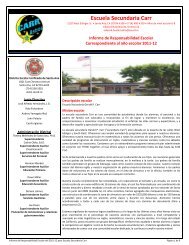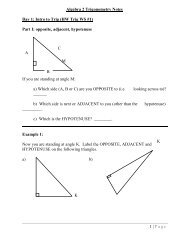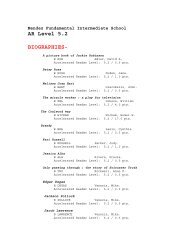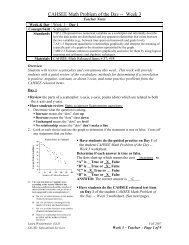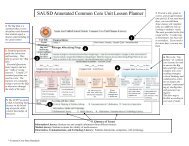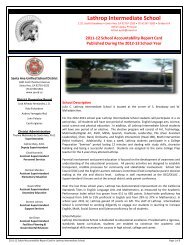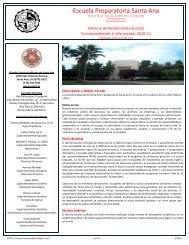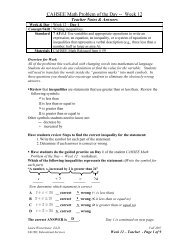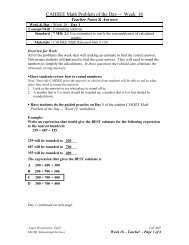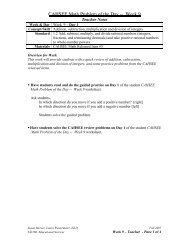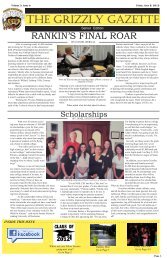Common Core Standards - Santa Ana Unified School District
Common Core Standards - Santa Ana Unified School District
Common Core Standards - Santa Ana Unified School District
You also want an ePaper? Increase the reach of your titles
YUMPU automatically turns print PDFs into web optimized ePapers that Google loves.
Silicon Valley Mathematics Initiative87 Members - <strong>School</strong> <strong>District</strong>s, Charter <strong>School</strong> Networks, and <strong>School</strong>sAlbany USDAlvord SD (Riverside County)Antioch <strong>Unified</strong> SDAspire Charter <strong>School</strong> NetworkAssumption <strong>School</strong> (San Leandro)Bayshore SDBelmont-Redwood Shores SDBerryessa SDBolinas – Lagunitas SDBrisbane SDBuckeye SDCambrian SDCampbell Union ESDCastro Valley USDCharter <strong>School</strong> of Morgan HillChicago Public <strong>School</strong>Creative Arts Charter (SF)CSU San BernardinoCotati – Rohnert ParkCupertino SDDade County <strong>School</strong>s (GA)Del Mar USD (San Diego Co)Discovery Charter <strong>School</strong>Dioceses of <strong>Santa</strong> ClaraDublin USDEast Side UHSDEdmonds Community CollegeEmery SDEtiwanda SD (San Bernardino Co)Gilroy (Brownell MS)Fairfield-Suisun USDFremont USDForsyth County <strong>School</strong> (GA)Hamilton County (Tn)Hayward USDJefferson ESDJefferson HSDLas Lomitas SDLa Honda-Pescadero SdLivermore USDLos Altos SDLos Gatos SDMenlo Park SDMonterey Peninsula USDMoreland SDMountain SDNational Council of La RazaNew York City PSNew Visions for Public <strong>School</strong>sOakland <strong>Unified</strong> SDPacifica SDPajaro Valley USDPalo Alto USDPittsburgh USDPortola Valley SDRavenswood City SDRiverside COERedwood City <strong>School</strong>sSacramento City USDSalinas City <strong>School</strong>sSan Carlos CLCSan Diego COESan Diego <strong>Unified</strong> <strong>School</strong> <strong>District</strong>San Francisco USDSMFC (Park <strong>School</strong>)San Jose <strong>Unified</strong> SDSan Leandro USDSan Ramon Valley USD<strong>Santa</strong> Clara USD<strong>Santa</strong> Cruz City <strong>School</strong>sSaint Michael’s <strong>School</strong> (Poway)Saint Patrick’s <strong>School</strong> (San Jose)SaratogaScotts Valley USDSCCOE County Court <strong>School</strong>sSequoia HSDSMCOE County Court <strong>School</strong>sSouth Cook Service <strong>District</strong>South San Francisco USDSumter County (GA)The Nueva <strong>School</strong>Union SDUniversity of Illinois, ChicagoValley Christen (Dublin)Valdosta City (GA)Walnut Creek SDWoodside SDSupportingTeaching andLearning ofMathematicsSince 1996
The state of mathematics education inAmerica
The Achievement GapNAEP 2009 US 4th Grade US 8th GradeAll Students 240 283Black 222 260White 248 292Hispanic 227 266Asian 255 300Low Income 228 266Mid-High Income 250 293English Learner 218 243English Fluent 242 284Source: U.S. Department of EducationNational Achievement of Education Progress(NAEP 2009 Math) The Nation’s Report CardApproximately 10 scale points is equivalent to a grade level of learning
NY TIMES April 29, 2009Persistent Racial Gap Seenin Students Test ScoresBy SAM DILLONThe achievement gap between white andminority students has not narrowed in recentyears, despite the focus of the No Child LeftBehind law on improving black and Hispanicscores, according to results of a federal testconsidered to be the nation’s best measure oflong-term trends in math and readingproficiency.
NAEP 2009 8th gradeNational Ave. 282Massachusetts (1st) 299California (49th) 270Where you liveand yourbackgroundcorrelates to howyou score ontests.
<strong>Common</strong> <strong>Core</strong> <strong>Standards</strong>:A New Direction linkingInstruction and Assessment
Three Central Authors<strong>Common</strong> <strong>Core</strong> State <strong>Standards</strong> in MathematicsBill McCallum Phil Daro Jason ZimbaCharges given to the authors:• All students College and Career Ready by 11 th grade• Internationally Benchmarked• Make the standards “Fewer, Clear and Higher”
1. Make sense of problems and persevere in solving them.2. Reason abstractly and quantitatively.3. Construct viable arguments and critique the reasoning ofothers.4. Model with mathematics.5. Use appropriate tools strategically.6. Attend to precision.7. Look for and make use of structure.MathematicalPractice8. Look for and express regularity in repeated reasoning.
State Senator Hancock"Several implementation issues arise by California adopting adifferent set of grade 8 math standards from other participatingstates. For example, instructional materials for use in Californiawould need to be different from those used by other states - theunique additional standards may increase the costs of thosematerials for our local school districts. In addition, assessmentconsortia will be developing assessment aligned to the commoncore standards and not the variation adopted in California. Thismay result in issues with our Algebra standards and curriculumnot being aligned with our assessment and accountabilitysystem."
California SB 1200Establishes an 11-member standards review commission to review andrecommend modifications to the 8th grade mathematics standards, to beappointed as follows:Requires the recommendations of the standards review commission andmodifications approved by the SBE to ensure all of the following:a) The rigor of the state common core standards is maintained so that all highschool graduates are prepared for college and careers, as specified in thecommon core standards.b) All of the common core standards developed by the national <strong>Common</strong> <strong>Core</strong><strong>Standards</strong> Initiative consortium are adopted.c) Modifications, including additions and revisions, amount to no more than 15%of the state common core standards adopted by the SBE.
Two Mathematics PathwaysTwo Regular Sequences:Traditional Pathway2 Algebra courses,1 Geometrycourse, with Probability andStatistics interwovenCourses in higher level mathematics: Precalculus, Calculus*,Advanced Statistics, Discrete Mathematics, AdvancedQuantitative Reasoning, or courses designed for career technicalprograms of study.Integrated Pathway3 courses that attend toAlgebra, Geometry, andProbability and Statistics eachyearAlgebra IIGeometryHigh <strong>School</strong>Algebra IMathematics IIIMathematics IIMathematics ITraditional PathwayTypical in U.S..Integrated PathwayTypical outside of U.S.16
States have joined Assessment Consortia funded by RttTPARCC StatesPartnership for Assessment of Readiness of College andCareers (PARCC) is being managed by Achieve, Inc., aWashington-based non-profit. There are 23 states andDC in PARCC.The SMARTER-Balanced Assessment Consortium is beingmanaged by San Francisco-based WestEd and its seniorprogram director, Stanley Rabinowitz. SMARTER-Balancedenlisted 31 states.At this point, both consortia are targeting the first test administration by 2014-15. Both say they willintegrate summative or end-of-the-year tests with interim and formative assessments that can guideinstruction during the year. Both are promising to include performance-based tasks, such asconducting a science experiment and writing short answers to questions, that are intended to showdeeper levels of learning and thinking than multiple choice questions supposedly can measure. Bothindicate that technology will play a major role.
Goals of Assessment“We must ensure that tests measure what isof value, not just what is easy to test. If wewant students to investigate, explore, anddiscover, assessment must not measure justmimicry mathematics.”Everybody Counts
CST – Released Items Algebra 1
Current vs. CCSSCurrent STAR Assessments• Grades 2-11, writing at 4 thand 7 th• Only paper & pencil option• Taken around 85% of theinstructional days• Only multiple choice• Part of the state and federalaccountability systemProposed CCSS Assessments• Grades 3-8 and 11, Grades 9 and 10available for states that choose touse them• Delivered via computer (Paper andpencil option available for 3 years)and are computer adaptive• Taken during the final 12 weeks ofschool• Performance tasks andcomprehensive end-of -yearcomputer adaptive assessmentwhich will some selected responseitems• Accountability system has not beenestablished yet
The System(Possible Scenario)
Claim-Evidence-WarrantA Model for <strong>Ana</strong>lyzing Arguments(adapted from the work of Stephen Toulmin)PARCC States
SMARTER – BalanceContent Specifications - CCSSM
Assessment: What We Know• Assessments will begin in 2014-15.• California is a governing state in the SMARTERBalanced Assessment Consortium.• Assessments will include:– Computer Adaptive Assessments(interim & summative)– Performance Assessments (interim & summative)• Selected Response• Technology Enhanced• Constructed Response• Performance Task• Extended Performance Event
Traditional Selected ResponseCST ExampleA company has 6 big trucks. Each truck has 18 wheels. Howmany wheels is this in all?A 24B 96C 108D 1162009 California <strong>Standards</strong> Test Released Test Question pg. 14, #34
Non-Traditional Selected Response
Non-Traditional SelectedResponse Rubric
Performance AssessmentsTo Inform Instruction And Measure Higher Level ThinkingTask DesignTopAccess<strong>Core</strong>RampEntry level (access into task)<strong>Core</strong> Mathematics - (meeting standards)Top of Ramp (conceptually deeper, beyond)• The Mathematics Assessment Resource Service (MARS) is an NSFfunded collaboration between U.C. Berkeley and the Shell Centre inNottingham England.• The Assessments target grades 2- Geometry and are aligned with theState and NCTM National Math <strong>Standards</strong>.
ApprenticeTask
PerformanceExams40,000 – 70,000students per yearsince 1999Students in grades 2through 10 th /11 th grade areadministered performanceexams (5 apprentice tasksper exam).<strong>District</strong>scoringleaders aretrained inusing taskspecificrubricsStudent results arecollected, analyzed,and reported by anindependent datacontractor.Random sample of studentpapers are audited andrescored by SJSU math & CSstudents. (Two readercorrelation >0.95)Student tests are handscored by classroomteachers trained andcalibrated using standardprotocols.
MAC vs. CST 2012Silicon Valley Mathematics InitiativeMathematics Assessment CollaborativePerformance Assessment Exam 2012
MAC vs CST 20122nd Grade MAC Level 1 MAC Level 2 MAC Level 3 MAC Level 4Far BelowBasic 1.0% 0.3% 0.1% 0.0%Below Basic 1.9% 2.4% 1.2% 0.0%Basic 1.3% 4.8% 5.5% 0.3%Proficient 0.4% 3.5% 17.7% 3.4%Advanced 0.3% 0.9% 23.4% 31.4%2nd Grade MAC Below MAC At/Above TotalCST Below 11.7% 7.1% 18.8%CST At/Above 5.1% 75.9% 81.0%Total 16.8% 83.0% 100%
Elementary Grades3rd Grade MAC Below MAC At/Above TotalCST Below 15.9% 5.2% 21.1%CST At/Above 13.7% 65.4% 79.1%Total 29.6% 70.6% 100%4th Grade MAC Below MAC At/Above TotalCST Below 16.9% 2.8% 19.7%CST At/Above 20.3% 60.0% 80.3%Total 37.2% 62.8% 100%5th Grade MAC Below MAC At/Above TotalCST Below 20.6% 3.8% 24.4%CST At/Above 18.7% 56.9% 75.6%Total 39.3% 60.7% 100%
Middle <strong>School</strong>6th Grade MAC Below MAC At/Above TotalCST Below 37.2% 1.4% 38.6%CST At/Above 25.1% 36.5% 61.6%Total 62.3% 37.9% 100%7th Grade MAC Below MAC At/Above TotalCST Below 33.3% 2.1% 35.4%CST At/Above 27.4% 37.1% 64.5%Total 60.7% 39.2% 100%Course 1 MAC Below MAC At/Above TotalCST Below 34.5% 3.6% 38.1%CST At/Above 30.3% 31.5% 61.8%Total 64.8% 35.1% 100%
8 th Graders Taking HS GeometryCourse 2MACBelowMACAt/AboveTotalCSTBelow 3.1% 0.8% 3.9%CSTAt/Above 51.3% 44.8% 96.1%Total 54.4% 45.6% 100%
Expert TasksThe main point inmathematics teachingis to develop thetactics of problemsolving.George Polya
SALLY’S SUGAR STACK
The measurement instrument will benovice [short] tasks. The itemsassessing this claim will account for40% of the total score administered bycomputer.The measurement instrument will beby apprentice [scaffold] tasks or expert[unscaffold] tasks. The items assessingthis claim will account for 20% of thetotal score and will be human scored.The measurement instrument will beby apprentice [scaffold] tasks or expert[unscaffold] tasks. The items assessingthis claim will account for 20% of thetotal score and will be human scored.The measurement instrument will beby apprentice [scaffold] tasks or expert[unscaffold] tasks. The items assessingthis claim will account for 20% of thetotal score and will be human scored.
Teaching for Meaning
Erica is putting up lines of colored flags for a party.The flags are all the same size and are spaced equally along the line.1. Calculate the length of the sides of each flag, and the space between flags.Show all your work clearly.2. How long will a line of n flags be?Write down a formula to show how long a line of n flags would be.
Algebra students had been working onsystem of linear equations for weeks.6x + 5y = 1703x + 2y = 806x + 5y = 170-6x + -4y = -160y = 10
The Findings from Party Flags• The task may be approached as a system ofsimultaneous equations, almost no algebra studentsused such an approach.• 49% of algebra students had no success.• 44% accurately found the two lengths (mostcommonly by an estimation strategy only using oneconstraint).• 21% correctly used both constraints (the length ofthree flags is 80 cm. and the length of 6 flags is 170cm.).• 7% of the students were able to develop a validgeneralization for n flags.
1. Make sense of problems and persevere in solving them.2. Reason abstractly and quantitatively.3. Construct viable arguments and critique the reasoning ofothers.4. Model with mathematics.5. Use appropriate tools strategically.6. Attend to precision.7. Look for and make use of structure.MathematicalPractice8. Look for and express regularity in repeated reasoning.
CCSS Mathematical PracticesOVERARCHING HABITS OF MIND1. Make sense of problems and persevere insolving them6. Attend to precisionREASONING AND EXPLAINING2. Reason abstractly and quantitatively3. Construct viable arguments and critique the reasoning of othersMODELING AND USING TOOLS4. Model with mathematics5. Use appropriate tools strategicallySEEING STRUCTURE AND GENERALIZING7. Look for and make use of structure8. Look for and express regularity in repeated reasoning
New K-12 Math Curriculum Inspired byThe <strong>Common</strong> <strong>Core</strong> State <strong>Standards</strong>The Gates Foundation and the Pearson Foundation arefunding a large scale project to create a system ofcourses to support the ELA and Mathematics CCSS.These will be a modular, electronic curriculum spanningall grade levels. A <strong>Santa</strong> Cruz based company, LearningIn Motion, is working to write the lessons.
Think in Terms of UnitsPhil Daro has suggestedthat it is not the lesson oractivity, but rather theunit that is the “optimalgrain-size for the learningof mathematics”. Hencethat was the startingpoint for our Scope andSequence.Developers of High <strong>School</strong>:Patrick Callahan, Dick Stanley,David Foster, Brad Findell,Phil Daro, and Marge Cappo
Two Mathematics PathwaysTwo Regular Sequences:Traditional Pathway2 Algebra courses,1 Geometrycourse, with Probability andStatistics interwovenCourses in higher level mathematics: Precalculus, Calculus*,Advanced Statistics, Discrete Mathematics, AdvancedQuantitative Reasoning, or courses designed for career technicalprograms of study.Integrated Pathway3 courses that attend toAlgebra, Geometry, andProbability and Statistics eachyearAlgebra IIGeometryHigh <strong>School</strong>Algebra ITraditional PathwayTypical in U.S..Mathematics IIIMathematics IIMathematics IIntegrated PathwayTypical outside of U.S.56
CCSS High <strong>School</strong> UnitsHigh <strong>School</strong> Algebra Units:A0 Introductory UnitA1 Modeling with FunctionsA2 Linear FunctionsA3 Linear Equations and Ineq in One VarA4 Linear Equations and Ineq in Two VarA5 Quadratic FunctionsA6 Quadratic EquationsA7 Exponential FunctionsA8 Trigonometric FunctionsA9 FunctionsA10 Rational and Polynomial ExpressionsHigh <strong>School</strong> Geometry Units:G0 Introduction and ConstructionG1 Basic Definitions and Rigid MotionsG2 Geometric Relationships and PropertiesG3 SimilarityG4 Coordinate GeometryG5 Circle and ConicsG6 Trigonometric RatiosG7 Geometric Measurement and DimensionM4 Capstone Geometric Modeling ProjectHigh <strong>School</strong> Prob & Stat Units:P1 ProbabilityS1 StatisticsS2 Statistics (Random Process)
TRADITIONALUS
INTERNATIONAL
A Mathematical BigIdeaLinear Equationsin Two Variables6x + 5y = 1703x + 2y = 80
Unit of StudyAround a Big IdeaPreassessmentMARS TaskInstructionPOM or ExpertInvestigationInstructionCCFALInstructionFinalAssessmentMARS Task1 day 5 - 10 days2 days 1 dayMath Talks
MATH TALKS
Math Talks• A daily ritual with the entire class for the purpose of developingconceptual understanding of and efficiency with numbers,operations and other mathematics such as geometry andalgebra. (no more than 10 minutes per day)Math Talks are used to:• Support active student engagement through signaling• Review and practice procedures and concepts• Introduce a concept before diving into the lesson of the day• Support students in deepening their understanding of theProperties of Arithmetic and our Place Value System• Explore mathematical connections and relationships• Encourage students to construct viable arguments and critiquethe reasoning of others• Support students in using precise mathematical language insharing their different strategies and approaches
Math Talk – Relational Thinking
Math Talk – Relational Thinking
Math Talk – Relational Thinking
Unit of StudyAround a Big IdeaPreassessmentMARS TaskInstructionPOM or ExpertInvestigationInstructionCCFALInstructionFinalAssessmentMARS Task1 day 5 - 10 days2 days 1 dayMath Talks
What Ever Happened to Problem Solving InMath Class?Silicon Valley Math InitiativeProblems of the MonthPromoting Problem Solving in Mathematics
“High-stakes testinghas encouraged adrill-and-practice formof instruction amongteachers who areperfectly capable ofdeveloping deepunderstanding on thepart of theirstudents.”Learning from Leadership Project,Univ. of Minnesota, Toronto
Problemsolving ismore thanthe wordproblems atthen end ofthe problemset orchapter.Hell’s Library
Problem Solving requires a depth of mathematicalknowledge.“Before we begin advanced calculus, let’s review any information wemay have forgotten over the summer.”
Problemsolvingrequiresperseverance“Mr. Osborne, may I be excused?My brain is full.”
ProblemSolving isaboutnon-routineproblems notmerelyproceduralknowledge.
“He was never any good at arithmetic, he left a third toyou, a third to me, a third to Shirley and a third to Max”Everyone canbecome agoodproblemsolver.
“How many times do I have to tell youyou’re not supposed to read ahead.”ProblemSolvingchallengesALLstudents.
Problems of the MonthA program tofosterschool-wideparticipationin math andproblemsolving.
George Polya, (1887 - 1985)Father of Problem Solving;“How to Solve It”, 1945Mathematics, you see, isnot a spectator sport. Tounderstand mathematicsmeans to be able to domathematics. And whatdoes it mean doingmathematics? In the firstplace it means to be able tosolve mathematicalproblems.
Why a Problem of the Month?• George Polya, said, “A problem is not a problem if you can solve it in24 hours.”• Doing math is solving non-routine problems.• Perseverance and learning from mistakes are important attributes ofgood mathematicians.
CCSS Mathematical PracticesOVERARCHING HABITS OF MIND1. Make sense of problems and persevere insolving them6. Attend to precisionREASONING AND EXPLAINING2. Reason abstractly and quantitatively3. Construct viable arguments and critique the reasoning of othersMODELING AND USING TOOLS4. Model with mathematics5. Use appropriate tools strategicallySEEING STRUCTURE AND GENERALIZING7. Look for and make use of structure8. Look for and express regularity in repeated reasoning
How are the POM be used?• The POM are used school wide to promoteproblem solving.• Each problem is divided into five levels, A-E, to meet the learning development needsof all students.• A great tool for Differentiated Instruction.• Students, teachers and parents learn to askquestions and persevere in solving nonroutineproblems.• The whole school celebrates doingmathematics at school.
It’s better to solve oneproblem five differentways than to solve fivedifferent problems.George Polya
Investigate(POM):Wheel Shop
“A problem isnot a problem ifyou can solve itin 24 hours.”George Polya
Creating a PosterYour concluding thoughts on anexplanation poster for a level you feelyou have completedANDYour current thoughts on a statusposter for a level you are stillexploring.
Break
Explanation Poster: The focus of your postershould be on how your findings can be justifiedmathematically and how your findings makesense. Include words and visuals (such asdrawings) as a part of your justification.*Remember to justify or explain your processes youhave used so far and why they make mathematicalStatus Poster: The focus of your poster shouldbe on your processes so far and where youthink you want to go next and/orquestions/wonderings you have about this level.Include words and visuals as a part of yourjustification.
Gallery Walk• Each group will display theirposter.• Each group selects a groupmember to be the docent toanswer questions or provideclarifications/explanations.• The other group membersexamines, explores, reviewsthe other groups’ posters.• There will be time for yourgroup to re-assemble anddiscuss the information sharedin the groups’ posters.• Please mind gallery walk normsand be respectful of the workand information shared.
Sincerely,Dear Parents,Problem solving is a fundamental goal of any strong mathematics program. Our school iscommitted to making each of our students a p roblem solver. It is never too early or toolate to develop the real life learning skills of problem solving. Therefore, our school isembarking on a Problem of the Month program to help achieve this important goal.Each month we will present our students with a non-routine problem for them to attackand solve. The problem will have several levels so that all students at our school will beable to work on a part of the problem appropriate to their learning development. Allstudents should start with level A and work through the different tasks. It is understoodthat some students will not get too far into the problem. The process of attacking andstruggling on a non-routine problem is important to learn. When your child has reachedthe maximum level of his/her understanding please celebrate their progress.Trials, errors, and retries are key attributes of good problem solvers. We ask you toencourage your students to persevere. M any students might want to initially give up.The best support for your student is encouragement through good questions. So me goodquestions are: What have you tried?, Why do you think it doesn’t work?, Ha ve you triedto make the problem simpler?, What do you need to know to be able to solve theproblem?. There are many other good questions; however leading or guiding questionsare not helpful. The process of finding and understanding a solution outweighs thebenefit of having a correct answer. Doing the problem for the student actually hurts theproblem solving process. Many students will receive the hidden message that they can’tsolve problems by themselves and, will learn to stop and wait for someone else toanswer.You will play an important role in supporting your child’s work on these problems. Oncestudents have reached their level of understanding, they are asked to complete a write-upof their findings. Students should communicate how they went about solving theproblem as well as the solution they found. This write up helps students understand howthey think and approach new problems. We look forward to a partnership with youaround problem solving. Thank you for supporting your child.
Teacher’s NotesProblem of the Month: Squirreling It AwayOverview:In the Problem of the Month, Squirreling It Away, students use number operations, organized lists and counting methods to solveproblems. The mathematical topics that underlie this POM are knowledge of number sense, comparison subtraction, division, factorsand divisibility, counting principles, systematic charting and closed-form equations. The mathematics that includes counting principlesand systemic charting is often referred to as discrete mathematics.In the first level of the POM, students are presented with a situation that involves making sense totals and comparison differences. Theirtask involves making number story about giving acorns to two difference size groups of squirrels and then determining how many wereleft over from of the original total of acorns. In level B, students start to examine how the acorns can be partitioned into different sets.The students are told that different squirrels can carry different amounts of acorns on given trips. Students are asked to find the numberof trips it takes to carry the acorn for each type of squirrel. In level C, students are asked how many ways can three different type ofsquirrels carry away 24 acorns. In level D, the student determines the number of ways 24 acorns can be divided between three specificsquirrels. In level E, students are asked to find and justify a closed form equation that will determine the number of ways that n acornscan be divided between three squirrels.Mathematical Concepts:Discrete mathematics is the study of the sets of and operations on discrete objects. Discrete means distinct from others, separate ordiscontinuous. Basically discrete is not continuous mathematics. Traditionally, K-12 mathematics starts with discrete topics in lowergrades, but by secondary mathematics the topics usually focus on continuous mathematics as a preparation for calculus. The realnumber line is an example of a continuous set of points. But, discrete mathematics plays important role in higher mathematics courses.Much of the mathematics that come from real life come in the form of distinct objects and values. Making sense of this distinctinformation and quantities is important, thus discrete mathematics has numerous applications to real life. A more formal definition ofdiscrete mathematics may be stated as the study of sets of distinct data. Tasks usually performed while doing discrete mathematicsinvolve
Findings are shared through Group Collaboration,Individual Write-Up, Gallery Walks, and/orPresentations
Problem of Month Write-up• Problem StatementIn your own words, state the general overall problem clearly enough that someoneunfamiliar with the problem could pick up your paper and understand what youare asked to do.• ProcessDescribe in detail how you attempted to solve this problem. You may want toconsider some of the following questions. You should also include things thatdidn’t work.How did you get started?What approaches did you t ry?Where did you get stuck?Did you talk to anyone about the problem?Did talking to someone help or hinder you?What drawing, chart, graph, or model did you us e?• SolutionState your solutions as clearly as you can. Include any charts, graphs, and listsand so on that you used to help you. If you were able to generalize the solution,include your results. Defend why you believe your solution is correct or the bestpossible answer. Your explanations should b e written in a way that will beconvincing to someone else.• LearningReflect on the problem. What did you learn? What mathematics did you use?
LUNCH BREAK
Unit of StudyAround a Big IdeaPreassessmentMARS TaskInstructionPOM or ExpertInvestigationInstructionCCFALInstructionFinalAssessmentMARS Task1 day 5 - 10 days2 days 1 dayMath Talks
Formative Assessment Lessons
Assessing Sample Student WorkYou are the teacher and have to assess thiswork.Correct the work and write comments on theaccuracy and organization of each response.•What do you like about this student’s work?•What method did the student use?Is it clear? Is it accurate? Is it efficient?•What errors did the student make?•How might the work be improved?107
!Sample Student Work: Ava108
Sample Student Work: Ethan109
Sample Student Work: Joe110
Sample Student Work: Mia111
Unit of StudyAround a Big IdeaPreassessmentMARS TaskInstructionPOM or ExpertInvestigationInstructionCCFALInstructionFinalAssessmentMARS Task1 day 5 - 10 days2 days 1 dayMath Talks
<strong>Common</strong> <strong>Core</strong> <strong>Standards</strong>:A New Direction linkingInstruction and AssessmentFour More Years to Implemented the CCSSM
Two Mathematics PathwaysTwo Regular Sequences:Traditional Pathway2 Algebra courses,1 Geometrycourse, with Probability andStatistics interwovenCourses in higher level mathematics: Precalculus, Calculus*,Advanced Statistics, Discrete Mathematics, AdvancedQuantitative Reasoning, or courses designed for career technicalprograms of study.Integrated Pathway3 courses that attend toAlgebra, Geometry, andProbability and Statistics eachyearAlgebra IIGeometryHigh <strong>School</strong>Algebra IMathematics IIIMathematics IIMathematics ITraditional PathwayTypical in U.S..Integrated PathwayTypical outside of U.S.118
Algebra Forever vs CCSSMArnold SchwarzeneggerJuly 8, 2008“We have madesignificant gainsin enrollingstudents inAlgebra I ineighth grade inrecent years,surpassing otherstate in the U.S.But we must setour goal higher.”We have also mademore significantgains in FAILINGstudents in AlgebraI in eighth grade inrecent years,surpassing otherstate in the U.S.3 out of 4 failed in2008California Adoptedthe CCSSM onAugust 2, 2010 withan addition 15% ofa traditionalAlgebra 1 courseand other addedstandards. Weselected PARCC asthe assessment tocomplete the Raceto the Topapplication that wenever won.
State Senator Hancock"Several implementation issues arise by California adopting adifferent set of grade 8 math standards from other participatingstates. For example, instructional materials for use in Californiawould need to be different from those used by other states - theunique additional standards may increase the costs of thosematerials for our local school districts. In addition, assessmentconsortia will be developing assessment aligned to the commoncore standards and not the variation adopted in California. Thismay result in issues with our Algebra standards and curriculumnot being aligned with our assessment and accountabilitysystem."
3x 2 – y = πA FLU NT
The California Algebra Experiment• In 2012, 59% of all eighth grade students took the CSTAlgebra 1 exam and more than half were not successful.Even more will repeated the class again in high school.• In 9 th grade, 49% of the students took CST Algebra 1 examand 75% of those students did not pass.• Research studies indicate nearly 65% of the students whowere placed in Algebra in eighth grade are placed in thesame level of Algebra in ninth grade.• About 46% of the students who were successful in Algebrain the eighth grade (B- grade and Proficient) and who wereplaced again in Algebra in ninth grade were less successfulin their second experience.It is Algebra Forever not Algebra for All
The word Algebra in the title of thecourse is a major hurdle to improvingstudent learning in mathematics.It leads to misplacement of students,tracking, and traditional beliefs that onlysome students can success atmathematics.
What’s in a Name?• Algebra is the greatest gatekeeper to higher education. (ETS1988)• There is no official Algebra 1 course, it differs greatly fromstate to state although they are all use the same title.• No other course a has such a failure rate. Teachers believethe Algebra 1 course must be difficult .• There is no mathematical reason why for a course to becalled Algebra (it is a misnomer). Algebra is a strand ofmathematics.• Failure in the course Algebra 1 is the single greatest reasonscited for dropping out in CA (Los Angeles Times 2009).• Algebra as a course is all about status.
New K-12 Math Curriculum Inspired byThe <strong>Common</strong> <strong>Core</strong> State <strong>Standards</strong>The Gates Foundation and the Pearson Foundation arefunding a large scale project to create a system ofcourses to support the ELA and Mathematics CCSS.These will be a modular, electronic curriculum spanningall grade levels. A <strong>Santa</strong> Cruz based company, LearningIn Motion, is working to write the lessons.
Think in Terms of UnitsPhil Daro has suggestedthat it is not the lesson oractivity, but rather theunit that is the “optimalgrain-size for the learningof mathematics”. Hencethat was the startingpoint for our Scope andSequence.Developers of High <strong>School</strong>:Patrick Callahan, Dick Stanley,David Foster, Brad Findell,Phil Daro, and Marge Cappo
Middle <strong>School</strong> Curriculum
CCSS High <strong>School</strong> UnitsHigh <strong>School</strong> Algebra Units:A0 Introductory UnitA1 Modeling with FunctionsA2 Linear FunctionsA3 Linear Equations and Ineq in One VarA4 Linear Equations and Ineq in Two VarA5 Quadratic FunctionsA6 Quadratic EquationsA7 Exponential FunctionsA8 Trigonometric FunctionsA9 FunctionsA10 Rational and Polynomial ExpressionsHigh <strong>School</strong> Geometry Units:G0 Introduction and ConstructionG1 Basic Definitions and Rigid MotionsG2 Geometric Relationships and PropertiesG3 SimilarityG4 Coordinate GeometryG5 Circle and ConicsG6 Trigonometric RatiosG7 Geometric Measurement and DimensionM4 Capstone Geometric Modeling ProjectHigh <strong>School</strong> Prob & Stat Units:P1 ProbabilityS1 StatisticsS2 Statistics (Random Process)
TRADITIONALUS
INTERNATIONAL
CCSSM 8 th Grade are HS <strong>Standards</strong>• Algebra/Functions 67%• Geometry(Transformations andTriangle Proofs) 20%• Bivariate Data10%• Cross-ConceptProject 3%
When do we Accelerate?????
Where toAccelerate?Can we live withoutunderstanding….Integer and theiroperationsDivision of FractionsRatio and proportionalreasoningExpression, Equationsand InequalitiesStatistics
Where to Accelerate?Can we live withoutunderstanding….Properties of rationalnumbers, percents,discounts, markups, etc.Rate and problemssolving using rateSimilarity, proportionalreasoningAlgebraic Modeling withEquationsProbabilityGeometry: Angles, Volume,Surface Area, 3-D shapes
When do they Accelerate in Japan?After 8 th Grade!!!!!!!
Where to Accelerate????
When do we Accelerate?????The Only Reasonable Answer for Learning: 9 th Grade!!!!
This site gets 10,000hits each week. 6,000to download POMs.
Curriculum inspired by the CCSSMAP’s Formative Assessment Lessons and Professional Development ModulesAssessment For LearningFormative Assessment Lessons (2 days) for High <strong>School</strong> and Middle<strong>School</strong>
Inside Mathematics Websitehttp://www.insidemathematics.orgMathematics Assessment ProjectUC Berkeley & Shell Centre for Mathematical Educationhttp://map.mathshell.org/materials/lessons.phpSilicon ValleyMathematics Initiativehttp://www.svmimac.org



